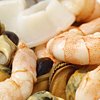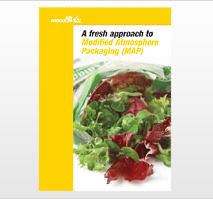Crustaceans and molluscs

Food items: Abalone, Clams, Cockles, Conch, Crab, Crayfish, Cuttlefish, Lobster, Mussels, Octopus, Oysters, Prawns, Scallops, Sea Urchins, Shrimp, Squid, Whelks and Winkles.
Recommended gas mix
The gases and mixtures listed above are for general guidance. To identify the optimum gas for your product and process, we recommend you undertake a product trial, with the help of an Air Products MAP gas specialist. If you would like a specialist to contact you to discuss this more click here. Storage temperature Achievable shelf-life Principle spoilage organisms and mechanics |
Food poisoning hazards include Typical MAP machines Typical types of package Examples of typical MAP materials Lidding and/or pillow
pack film: Bulk |
 The principal spoilage mechanisms affecting the quality of fish and seafood are the result of microbial and oxidative activities. Fish and seafood products are very perishable due to their high aw, neutral pH, and presence of autolytic enzymes which cause the rapid development of undesirable odours and flavours.
The principal spoilage mechanisms affecting the quality of fish and seafood are the result of microbial and oxidative activities. Fish and seafood products are very perishable due to their high aw, neutral pH, and presence of autolytic enzymes which cause the rapid development of undesirable odours and flavours.
Fish normally have a particularly heavy microbial load owing to their cold water origins, method of capture and transport to shore, evisceration and retention of skin in retail portions. Microbial activity causes a breakdown of fish protein, with resulting production of undesirable fishy odours. Oxidative rancidity of unsaturated fats in oily fish also results in other additional offensive odours and flavours.
MAP is a very effective technique for delaying microbial spoilage and oxidative rancidity in fish and seafood products. MAP is particularly effective at extending the shelf-life of white fish products. For white fish, crustaceans and molluscs, a gas mixture containing 30% O2, 40% CO2, and 30% N2 is recommended. A gas mixture containing 40% CO2 and 60% N2 is recommended for oily fish products. The inclusion of CO2 is necessary for inhibiting common aerobic spoilage bacteria, such as Pseudomonas species (in air).
However, for retail packs of fish and other seafood, too high a proportion of CO2 in the gas mixture can induce pack collapse, excessive drip, and in cold-eating seafood products such as crab, an acidic, sherbet-like flavour.
O2 is necessary to prevent the growth of Clostridium botulinum type E, colour changes and bleaching, and reduce drip in white fish, crustacean and mollusc MA packs. However, O2 is preferentially excluded from oily fish MA packs so as to inhibit oxidative rancidity. A gas/product ratio of 2:1 is recommended.
Only the highest quality fish and seafood should be used to benefit from the extended shelf-life advantages of MAP. The Achievable shelf-life will depend on the species, fat content, initial microbial load, gas mixture, and temperature of storage. The maintenance of recommended chilled temperatures and good hygiene and handling practices throughout the entire capture-to-consumption chain is essential for ensuring the safety and extended shelf-life of fish and seafood products.




